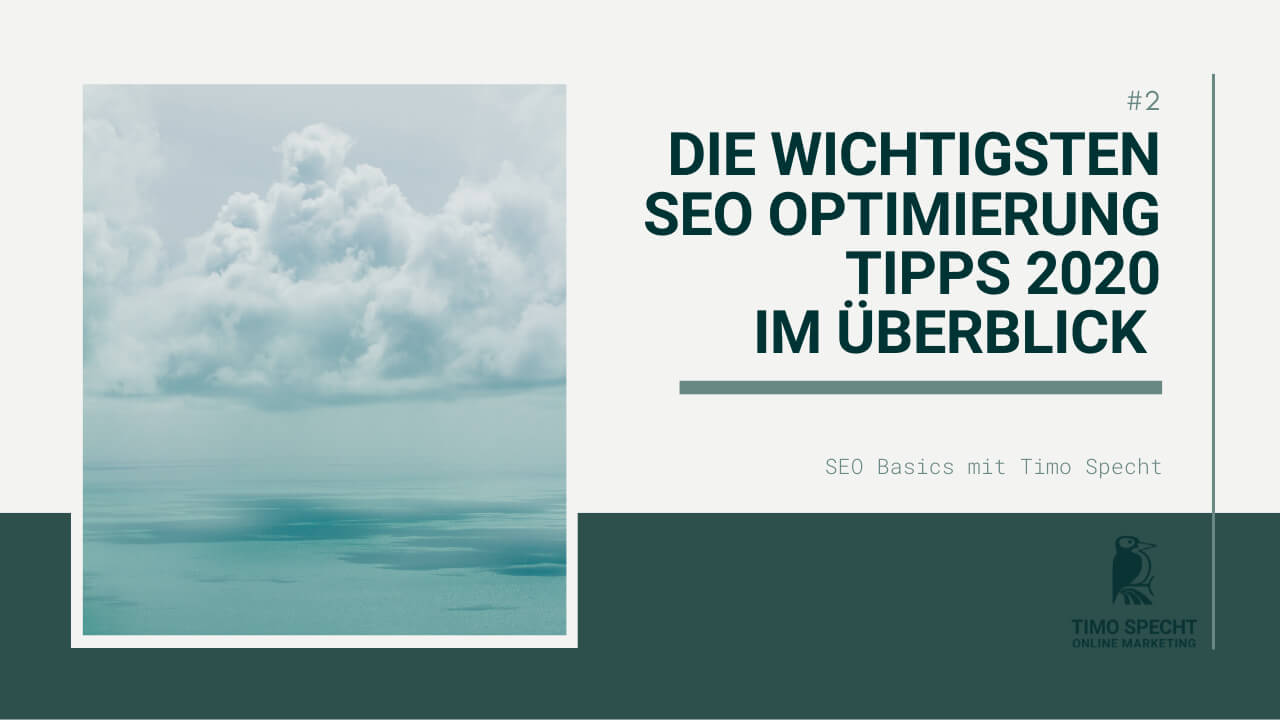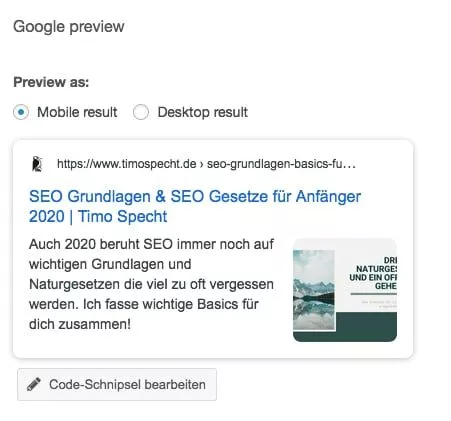Looking back: What was and what is still the idea behind SEO?
First of all, I would like to briefly explain what SEO is all about.
As the Internet slowly spread, it quickly became confusing. The first search engines were launched. They all worked with a full-text search and showed the user matching results to the search query - but not sorted by quality.
Then Google came along and revolutionized the market. The specially developed PageRank system meant that there was not just a match between the search query and the content on the page. Instead, Google took the quality of the page into account when calculating the relevance value and the search results became much more user-friendly.
Search engine optimization is therefore about convincing Google & Co that your own site offers high-quality information and at the same time perfectly matches the user's search query.
Some people may assume that SEO is a way of tricking Google & Co. to help your own site achieve good rankings. This is definitely not true! Such methods simply no longer work in 2022.
-
Free
SEO strategy meeting
In a free SEO strategy consultation, we uncover untapped potential and develop a strategy to make you more successful on Google.

- More organic visibility
- More organic visitors to your website
- More inquiries & sales
SEO optimization 2022 - Make your site fit!
A large part of search engine optimization takes place on your website. So-called crawlers (i.e. search engine bots) access countless pages every day and check where new content has been added or whether something else has changed.
Although the algorithm has been improved and refined many times over the last 10 years, the following still count fundamental optimization factors are still included in your ranking.
- URL structure
- Heading structure
- META tags
- Quality of the content
- Page speed
- Internal linking
- BACKLINKS / Social Signals
We will now take a closer look at all these aspects.
Ensure a sensible URL structure
The URL structure of your site is an essential building block for successful search engine optimization. Say goodbye to long, cryptic URLs
(e.g. www.meineseite.de/ordner1/unterordner2/unterunterordner3/überschrift-des-artikels.html).
Instead, you should work with URLs that are as short and concise as possible and that also contain the (most important) keyword for which you want to optimize your page.
Mark up headings correctly
Once you have tidied up the URL structure, you should look at the heading structure of your page. Make sure that each subpage only has one H1 heading.
This is the main heading of the page and all other headings (H2 to H3) are subordinate to it. Furthermore, no heading hierarchy should be skipped.
My tip
Think of the heading structure as the table of contents of a reference book. All H2 headings are new topics that are directly subordinate to the main topic. H3 headings are in turn subordinate to individual H2 headings, H4 headings are subordinate to individual H3 headings ... and so on!
Meta title & meta description - The blurb for your website
The so-called meta tags are something like the blurb on the spine of literary works. They are displayed in the search engine results and can increase the likelihood that a user will click on your search result. They are also a ranking factor.
Optimize meta title
The meta title offers you approx. 60 characters of space to summarize the topic of the (sub)page in a few words.
Optimize meta description
The meta description comprises approx. 160 characters. Here you can integrate a short summary of the content and arouse the reader's curiosity.
Improve the quality of content
High-quality content is real gold when it comes to search engine optimization. Only sites that offer their visitors information with high added value have a chance of achieving a good ranking.
This means that the user must find the exact answer to the questions he or she asked during the search on a page.
When creating and optimizing content, you should always ask yourself exactly what search intentions your target group might have. There are special W-question tools that can help you determine the most common questions that users type into the search mask for a specific topic.
In the past, it was important to include as many keywords as possible in the texts, as Google & Co. strongly matched the search queries with the written content.
Nowadays, this is no longer so important. Search engines have become smarter and can therefore recognize synonyms and capture the content of a text without you having to serve them the corresponding keywords on a silver platter.
Of course, you should think about which topic you want to work on with a text. And if the keyword can be used well in the text, you should definitely do this. However, I recommend that you always prioritize readability.
My tip
Update your content regularly to show Google & Co that you are constantly working on your site. Only if you offer up-to-date and relevant information will you satisfy your readers.
Providing more content variation
Content is much more than clumsy text. Start thinking broadly here.
Content counts:
- Text
- Image
- Video
- Audio / Podcast
- PDF's
- Infographics
- and much more.
Page speed - search engines love high speed
Google & Co are increasingly evaluating how comfortable the user feels on a page. One thing is clear: nobody wants to wait forever for the website to load. This is why fast websites are clearly preferred by search engines in the rankings.
Make sure that your website also loads fast enough on mobile devices. The "mobile first" approach should be taken into account when designing your website. This means that the focus is on the mobile display of the website.
You can check the PageSpeed of your site here: HTTPS://DEVELOPERS.GOOGLE.COM/SPEED/PAGESPEED/INSIGHTS/
Google will also immediately show you some ways to improve the speed of your site. A common problem, for example, is images that are too large. However, you may also want to change hosting providers if your values are miserable.
Internal linking - Guide the user to their destination
- I am one of the leading SEO experts in Germany
I am known from big media such as Stern, GoDaddy, Onpulson & breakfast television and have already worked with over 100+ well-known clients successful on Google.
Google rating
Based on 185 reviews
Trustpilot rating
Based on 100 reviews
A rule of thumb says that each subpage should be reached with a maximum of three clicks from the homepage. With clever internal linking , you can cleverly guide the user through your site.
Crawling bots also use internal links to navigate to your site. Make life easy for the bots and at the same time ensure that your users stay on your site for longer - this is also noticed by search engines and improves the ranking.
In addition, the power and trustworthiness that Google & Co attribute to your site can be distributed to your site in the form of internal links. SEOs like to refer to this as "link juice" - a fictitious liquid that is distributed across your entire site and ideally arrives where you need the most power.
Backlinks & social signals produce linkjuice
But where does this linkjuice actually come from? Even in 2022, the source of this is still backlinks. If another site links to your site, this is equivalent to a recommendation and therefore an indication of the high quality of the content offered.
However, unlike in the past, nowadays you have to pay much more attention to ensuring that the linking page is thematically relevant to your site. In addition, Google will classify a link that generates practically no traffic as less valuable.
Social signals are also becoming increasingly important. You should definitely be on Facebook with your page, YouTubeInstagram and - where appropriate - also on LinkedIn and XING. How exactly social signals affect the ranking is not 100% known. However, it is conceivable that pages that are popular on social networks also receive a ranking boost on Google & Co.
- Do you know my SEO newsletter?
Register now and receive regular tips from the experts.
Conclusion - lay the foundations and don't play tricks!
In conclusion, it can be said that proper search engine optimization involves a lot of precise work, which takes a lot of time and must be continuously maintained (which brings us back to SEO SUCCESS).
With the tips from this article, you can work through the SEO basics and create the foundation for a good ranking. Please don't look for the shortcut or the fast lane - they simply don't exist in (serious) search engine optimization!
I promise you: Honest work pays off with Google & Co in the end!



